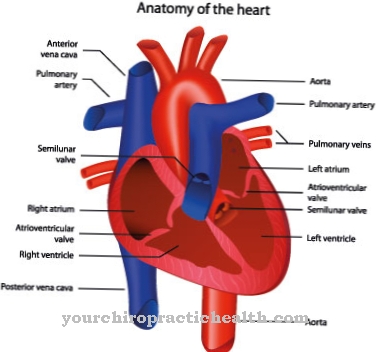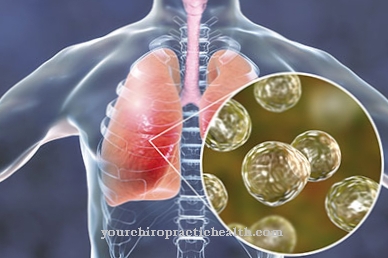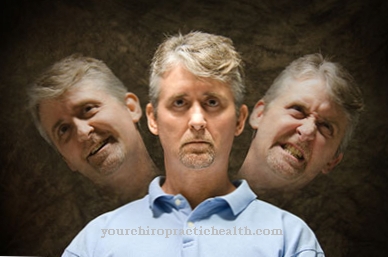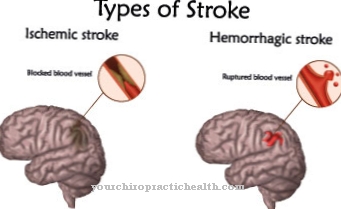The Trichinellosis respectively Trichinosis is one of the infectious diseases caused by parasites. The reportable disease is one of the most widespread human worm diseases worldwide.
What is trichinella?

© Jacek Chabraszewski - stock.adobe.com
The Trichinellosis is a worm disease caused by the larvae of trichinae. Trichinae can enter the human body through the consumption of raw or undercooked meat. Pork is particularly dangerous, but also meat from other domestic or wild animals. Pigs or wild animals are the carriers of the parasite, humans are intermediate or final hosts.
causes
Trichinae are tiny roundworms. They can be found in raw meat, especially pork, or meat from wild animals.
If a person eats this meat raw or insufficiently fried or cooked, the larvae of these roundworms get into the stomach of the person. The enzymes in the stomach are ideally suited for the larvae to free themselves from their cocoons. The movements of the intestine move the larvae into the small intestine. There they nest in the intestinal wall and grow into adult worms within 24 to 30 hours. Then mating takes place, after which the males quickly die off.
However, a fertilized female can produce up to 1500 larvae in the intestinal wall. From here they get into the human bloodstream. The females themselves survive up to 8 weeks.
The worms finally reach their full development in the striated muscles, in which the parasites encapsulate and damage the muscles. This mainly affects muscles with good blood circulation (shoulder girdle and upper arms, neck and masticatory muscles). The eyes, tongue and diaphragm can also be affected.
Symptoms, ailments & signs
The course of trichinella depends both on the number of larvae ingested and on the immune system. In addition to very severe clinical pictures, some of which are fatal, there are also mild forms of trichinella, which are often not recognized. After an incubation period of five to fourteen days, intestinal complaints first appear, as the larvae are initially located in the intestinal mucosa.
There is a severe feeling of illness with abdominal pain, diarrhea, fatigue and insomnia. In a second phase, the larvae migrate into the muscles via the bloodstream. This stage is initially characterized by a very high fever of up to 41 degrees Celsius, chills, eye infections and hoarseness.
Muscle pain is added later in a variety of muscles. After about three to four weeks, muscle pain and fever subside. Without treatment, however, several symptoms such as muscle pain, muscle and joint stiffness, paresthesia, sensory disorders, conjunctivitis of the eyes or increased sweating can persist for a long time.
However, these symptoms usually go away completely after a year. Since the larvae can also partially encapsulate themselves in the central nervous system, neurological complaints are sometimes observed. But there are also very severe courses of the disease, which not infrequently lead to death. Heart muscle inflammation, brain inflammation, pneumonia or even sepsis can be dangerous complications.
Diagnosis & course
Initially, a patient shows with a Trichinellosis Symptoms of gastrointestinal disease. When the trichinae get into the human gastrointestinal tract, nausea, vomiting and diarrhea occur. A fever is also possible. However, the symptoms do not have to occur in all affected patients.
In the second phase, the actual symptoms of the infectious disease appear. The worms have entered the bloodstream and eventually the muscles, causing a high fever and muscle pain. At first, the patient often thinks the muscle pain is joint pain.
There are also swallowing and breathing problems. Edema forms around the eyes. Conjunctivitis and rash are also possible. The symptoms can persist for a year and usually heal without complications.
The doctor confirms the diagnosis with a blood and stool test of the patient. Antibodies in the patient's blood indicate trichinellosis. At a later stage, a sample of the muscle tissue is also indicative.
Complications
An infection with roundworms of the genus Trichinella can take very different courses. In mild cases, when only a small number of larvae have been ingested, the infection is often mistaken for an upset stomach and heals quickly without complications. In the case of severe forms of the disease, on the other hand, a whole range of serious complications and even death can occur.
In severe infections, the typical symptoms initially increase. The often observed muscle hardening as well as the muscle and joint pain no longer only occur when trying to move, but also when you are resting. The typical hoarseness can become so severe that the patient temporarily loses his voice, and severe swallowing problems can make intravenous feeding necessary.
Breathing problems can lead to an acute risk of suffocation. If the eye muscles are affected, migraine-like headaches and visual disturbances can also occur, and those affected often perceive double vision. In addition to encephalitis, the most dangerous complications also include secondary infections such as bronchopneumonia or sepsis.
Myocarditis (inflammation of the heart muscle), which is associated with permanent damage to the organ, cannot be ruled out. In the worst case, which is rare in industrialized countries, the disease becomes life-threatening and ends with the death of the patient.
When should you go to the doctor?
If there is a decrease in well-being, a persistent feeling of illness or fatigue, there is cause for concern. If the irregularities persist for a long time or if they increase in intensity, a doctor is required. Abdominal pain, chills, increased body temperature and hoarseness should be examined and treated. Muscle pain, sensitivity disorders and abnormalities in the musculoskeletal system should be presented to a doctor. Sleep disorders, exhaustion and a decrease in the usual resilience are further indications of an illness.
If there are irregularities or functional disorders of the digestive tract, medical help is required. Since trichinella is one of the notifiable diseases, special care must be exercised in the event of abnormalities when using the toilet. If worm movements or other activities are found in the stool, this should be discussed with a doctor. Sweating, stiffening of the joints or an irregularity in the eye region are other complaints that require action.
Without a doctor's consultation and medical care, the person concerned can die if the disease progresses seriously. For this reason, a doctor is needed as soon as there are discrepancies in memory, heart rhythm or breathing. In the event of neurological failures, an ambulance service must be alerted. Disturbances of consciousness, severe pain, coordination difficulties and a body temperature above 40 ° must be presented to a doctor immediately.
Treatment & Therapy
Will the Trichinellosis recognized in time, drug treatment is possible. The severity of the infection depends on how many larvae the patient has ingested.
For therapy, the doctor prescribes drugs that kill the worms and larvae in the patient's body. An early start of therapy harbors the possibility that the worms will not implant themselves in the patient's muscles.
If the amount of pathogen ingested is very high, complications can occur and trichinella can also be fatal. Complications are heart disease (inflammation of the heart muscle), pneumonia, or blood poisoning. Meningitis and meningitis are also a possible complication.
The doctor reports the trichinella disease to the health department, which then has the task of finding out where the meat comes from and who the meat producer is. In this way, possible other affected parties can be found.
prevention
The most important prevention is not to eat meat raw or not cooked enough. A cooking temperature of at least 65 degrees Celsius will definitely kill larvae in the meat. The pathogens also do not survive prolonged freezing (at least 20 days below -15 degrees Celsius). In contrast, curing, smoking, salting or drying does not kill the pathogens.
In Germany, meat is also checked for trichinae by law. Caution should be exercised when importing meat from non-EU countries or consuming raw or undercooked meat abroad, as there are no laws there to test meat for trichinae.
Aftercare
In principle, the further course of the trichinella will continue to be monitored by a doctor even after the diagnosis and treatment. The aftercare measures usually focus on the care of the damaged muscles and the prevention of irreversible damage to the muscles. The scope of the follow-up examinations and treatments for trichinellosis depends on the effectiveness of the treatment measures.
Because the disease is regularly first treated with medication (anthelmintic based on benzimidazoles). The drug intervention is only effective as long as the trichinae larvae migrate or are in the intestines of the person affected. As soon as the larvae have arrived in the striated muscles, the success of the therapy is no longer guaranteed. The parasite then finally encapsulates and damages the muscles.
The parasite capsule only calcified after a year. Much later, calcification also sets in in the parasite itself. The focus of the follow-up measures is now on the symptoms that may arise as a late consequence. Neurological focal symptoms (e.g. muscle twitching) are often observed. The cause of this are trichinae larvae encapsulated in the central nervous system.
The neurological symptoms are regularly examined during follow-up care and medically alleviated. In individual cases, symptoms can even be life-threatening, so that chemotherapy is necessary as a follow-up treatment. Rheumatic pain and chronic ailments (e.g. anemia) are treated lifelong with medication as part of the follow-up care.
You can do that yourself
In the event of an infection with the trichinella pathogen, all possible sources of infection must first be removed. The health authority and, if necessary, various veterinary and food control authorities must be informed. They will back up the diagnosis and, if necessary, identify other affected persons. In addition, it must be determined where the infected meat comes from. To this end, the person concerned must be questioned in detail whenever the opportunity arises.
After the actual treatment, which is usually medicated using mebendazole, the patient needs a lot of bed rest. The immune system is severely weakened, especially after chemotherapy, as it is carried out for very advanced diseases, and protection is essential. The most important measure is to take the prescribed medication according to the instructions. The earlier the therapy is started, the less aggressive action has to be taken against trichinella. Nevertheless, the patient usually has to be placed in quarantine in order to minimize the risk of infection.
If symptoms of the lungs, the cardiovascular system or the brain occur after the initial treatment, the responsible doctor must be informed immediately. The Federal Institute for Risk Assessment provides those affected with additional information on the prevention and treatment of trichinella.

.jpg)























.jpg)

.jpg)
